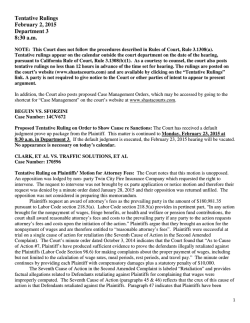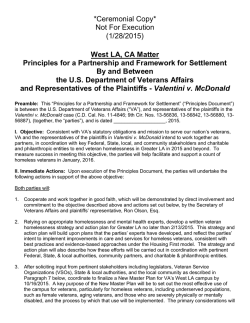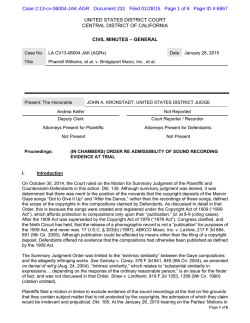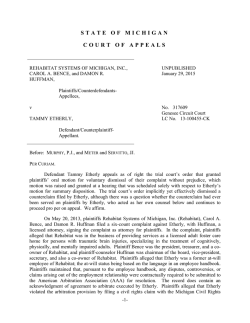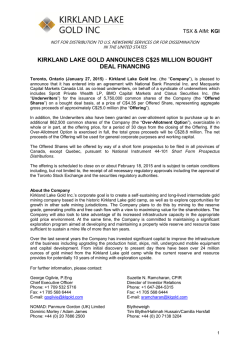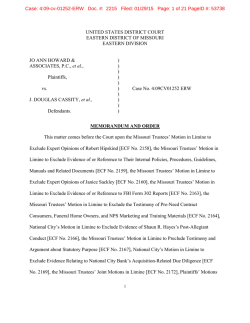
Opinion
UNITED STATES DISTRICT COURT FOR THE EASTERN DISTRICT OF TENNESSEE AT KNOXVILLE Defenders of Wildlife, et al., Plaintiffs, v. Sally Jewell, Secretary, U.S. Department of the Interior, et al., Defendants. ) ) ) ) ) ) ) ) ) ) Case No. 3:13-cv-698-PLR-CCS MEMORANDUM OPINION AND ORDER The Defenders of Wildlife, Sierra Club, Statewide Organizing for Community Empowerment, and the Tennessee Clean Water Network brought this action against the defendant government agencies for alleged violations of the Endangered Species Act. The plaintiffs contend these agencies have ignored “mounting evidence that high conductivity wastewater from surface coal mines harms two rare ESA-protected fish species,” and that they have failed to fulfill their obligations under Section 7 of the Endangered Species Act to consult on the effects of such wastewater discharge to ensure it does not jeopardize the continued existence of these fish species or damage critical habitat. The defendants have moved to dismiss the plaintiffs’ complaint under Federal Rule of Civil Procedure 12(b)(1) for lack of standing. (R. 80). For the reasons discussed below, the defendants’ motion will be granted in part and denied in part. Case 3:13-cv-00698-PLR-CCS Document 101 Filed 01/28/15 Page 1 of 17 PageID #: 919 BACKGROUND A. Legal Background i. The Endangered Species Act In 1973, finding that “various species of fish, wildlife, and plants in the United States have been rendered extinct as a consequence of economic growth and development untempered by adequate concern and conservation,” Congress passed the Endangered Species Act. 16 U.S.C. §§ 1531 et seq. Stated purposes of the Act include providing “a means whereby ecosystems upon which endangered species and threatened species depend may be conserved” and providing “a program for the conservation of such endangered species and threatened species.” 16 U.S.C. § 1531(b). The Supreme Court has explained: The plain intent of Congress in enacting this statute was to halt and reverse the trend toward species extinction, whatever the cost. . . . [T]he legislative history undergirding § 7 reveals an explicit congressional decision to require agencies to afford first priority to the declared national policy of saving endangered species. The pointed omission of the type of qualifying language previously included in endangered species legislation reveals a conscious decision by Congress to give endangered species priority over the ‘primary missions’ of federal agencies. Tennessee Valley Auth. v. Hill, 437 U.S. 153, 184-85 (1978). In TVA v. Hill, the Supreme Court further noted that “[o]ne would be hard pressed to find a statutory provision whose terms were any plainer than those in § 7 of the Endangered Species Act.” Id. at 174. Under Section 7(a)(2) of the Endangered Species Act, federal agencies are required to consult with the Secretary of the Interior to “insure that any action authorized, funded, or carried out” by the acting agency “is not likely to jeopardize the continued existence of any endangered species or threatened species or result in the destruction or adverse modification” of critical habitat. 16 U.S.C. § 1536(a)(2). Accordingly, federal agencies are required to consult with the U.S. Fish and Wildlife Service whenever their actions “may affect” listed species or critical 2 Case 3:13-cv-00698-PLR-CCS Document 101 Filed 01/28/15 Page 2 of 17 PageID #: 920 habitat for those species. 50 C.F.R. § 402.14(a). On the other hand, the consultation requirement is excused if the acting agency and the Fish and Wildlife Service conclude that the proposed action “is not likely to adversely affect listed species or critical habitat.” 50 C.F.R. 402.13(a). An action will “jeopardize the continued existence” of a species if it “reasonably would be expected, directly or indirectly, to reduce appreciably the likelihood of both the survival and recovery of a listed species in the wild by reducing the reproduction, numbers, or distribution of that species.” 50 C.F.R. § 402.02. An action will result in the “destruction or adverse modification” of critical habitat if it results in “a direct or indirect alteration that appreciably diminishes the value of critical habitat for both the survival and recovery of a listed species.” Id. In performing the required consultation, the Fish and Wildlife Service and the acting agency must “use the best scientific and commercial data available” to evaluate the impact of the proposed action on listed species or critical habitat, and the Fish and Wildlife Service must provide its “biological opinion” on whether, as a result of those impacts, the action will result in jeopardy or adverse modification. 16 U.S.C. §§ 1536(a)(2) & (b)(3); 50 C.F.R. § 402.14(g). If the Fish and Wildlife service concludes that the proposed action is likely to jeopardize the continued existence of a listed species or the destruction of critical habitat, it “shall suggest those reasonable and prudent alternatives” that it believes would avoid such a result. 16 U.S.C. § 1536(b)(3). If, on the other hand, the Fish and Wildlife service concludes that the proposed action is not likely to result in jeopardy or the destruction of critical habitat, it “shall provide” the acting agency with a written statement setting forth: (1) the impact of incidental taking on the species; (2) “reasonable and prudent measures . . . necessary or appropriate to minimize such impact;” and (3) the terms and conditions the acting agency must comply with to implement 3 Case 3:13-cv-00698-PLR-CCS Document 101 Filed 01/28/15 Page 3 of 17 PageID #: 921 those “reasonable and prudent measures.” 16 U.S.C. § 1536(b)(4). This written statement is known as an “Incidental Take Statement” or “ITS.” The Fish and Wildlife Service, as well as the acting agency, have ongoing duties to ensure against jeopardy or adverse modification. Both parties are independently obligated to reinitiate formal consultation if: (1) the amount or extent of the taking specified in the ITS is exceeded; (2) new information reveals that the action may affect listed species or critical habitat in a manner or to an extent not previously considered; (3) the action is subsequently modified such that it causes an effect to the listed species or critical habitat that was not considered in the biological opinion; or (4) a new species is listed or critical habitat is designated that may be affected by the identified action. 50 C.F.R. § 402.16. The Endangered Species Act also includes a citizen-suit provision, the “obvious purpose” of which is to “encourage enforcement [of the Endangered Species Act] by so called ‘private attorneys general.’” Bennett v. Spear, 520 US. 154, 155 (1997). Title 16 U.S.C. § 1540(g)(1)(A) provides: Except as provided in paragraph (2) of this subsection any person may commence a civil suit on his own behalf – (A) to enjoin any person, including the United States and any other governmental instrumentality or agency (to the extent permitted by the eleventh amendment to the Constitution), who is alleged to be in violation of any provision of this chapter or regulation issued under the authority thereof. The sole jurisdictional limitation to the Endangered Species Act’s citizen-suit provision is a requirement that litigants provide written notice of a violation to the Secretary of the Interior and any alleged violators at least 60 days prior to commencing their action. 1 16 U.S.C. § 1540(g)(2)(A). 1 The plaintiffs satisfied this requirement by letter to the defendants dated January 29, 2013. (See R. 1-1, plaintiffs notice letter, Page ID 24-41). 4 Case 3:13-cv-00698-PLR-CCS Document 101 Filed 01/28/15 Page 4 of 17 PageID #: 922 ii. The Surface Mining Control and Reclamation Act The Surface Mining Control and Reclamation Act of 1977 (“SMCRA”) establishes “a nationwide program to protect society and the environment from the adverse effects of surface coal mining operations.” 30 U.S.C. § 1202(a). To do so, SMCRA contains a permit system that requires mine operators to submit specific information concerning the environmental consequences of a proposed mining operation and a plan for reclaiming the affected lands. 30 U.S.C. §§ 1256-1264. SMCRA also contains certain environmental performance standards that govern surface mining operations after a permit has been issued and mining has begun. 30 U.S.C. §§1265-66. SMCRA is implemented by a Regulatory Authority, which, in the state of Tennessee, is the Office of Surface Mining, Reclamation and Enforcement (the “OSM”). 30 U.S.C. § 1254; 30 C.F.R. § 942. SMCRA’s implementing regulations require the OSM to find, in writing, prior to issuing a permit that the proposed mining operation “would not affect the continued existence of endangered or threatened species or result in the destruction or adverse modification of their critical habitats, as determined under the Endangered Species Act of 1973.” 30 C.F.R. §§ 773.15(j) and 942.773. SMCRA also prohibits the “taking” of an endangered or threatened species in violation of the Endangered Species Act. 30 C.F.R. § 816.97(b). SMCRA contains an administrative process through which interested parties may participate in the permitting decision process. A party interested in or adversely affected by a proposed mining permit may file written objections to the application for a permit within 30 days of the last publication of the notice of permit application. 30 U.S.C. § 1263(b); 30 C.F.R. §§ 773.6(b) and 942.773. The interested party may then request a hearing within 30 days after they are notified of the OSM’s final decision on the permit application. 30 U.S.C. § 1264(c); 30 5 Case 3:13-cv-00698-PLR-CCS Document 101 Filed 01/28/15 Page 5 of 17 PageID #: 923 C.F.R. §§ 775.11 and 942.775. Judicial review under SMCRA is only available to persons who have participated in the administrative proceedings as an objector. 30 U.S.C. § 1264. When Congress passed SMCRA, it included language broadly stating that “[n]othing in this chapter shall be construed as superseding, amending, modifying, or repealing . . . the National Environmental Policy Act of 1969 . . . or any of the following Acts or with any rule or regulation promulgated thereunder, including, but not limited to,” among others, the Clean Air Act, the Fish and Wildlife Coordination Act, the Federal Water Pollution Control Act “or any other Federal laws relating to the preservation of water quality.” 30 U.S.C. § 1292(a). B. Factual and Procedural Background The plaintiffs challenge the OSM’s issuance of SMCRA permits for two coal mines— Zeb Mountain Mine No. 7 and Davis Creek Mine Area 5—based on the defendants’ alleged failure to adequately consider how wastewater discharges from the mines would impact the Cumberland darter and blackside dace, two fish species protected by the Endangered Species Act. According to the plaintiffs, the OSM issued these mining permits without completing sitespecific and species-specific Endangered Species Act consultations with the U.S. Fish and Wildlife Service. The OSM has allegedly relied on a 1996 Biological Opinion to excuse its failure to consult with the Fish and Wildlife Service. However, according to the plaintiffs, reliance on the 1996 Biological Opinion to satisfy its Endangered Species Act consultation obligation is unreasonable because the 1996 Opinion does not analyze the blackside dace, the Cumberland darter, the impacts of coal mining wastewater discharges, or these specific mines in Tennessee. Moreover, the plaintiffs contend OSM has unlawfully failed to consult on dace conservation guidelines or reinitiate consultation on the SMCRA permits and 1996 Opinion in light of the 2011 listing of the darter, new scientific information regarding the harmful effect of 6 Case 3:13-cv-00698-PLR-CCS Document 101 Filed 01/28/15 Page 6 of 17 PageID #: 924 high-conductivity wastewater on these fish, and evidence that mining wastewater has decimated or extirpated populations of the dace and darter. The plaintiffs filed their eight-count complaint on May 16, 2013, in the United States District Court for the Middle District of Tennessee. (R. 1). The case was later transferred to this Court. (R. 58). jurisdiction. On May 1, 2014, the defendants filed a motion to dismiss for lack of (R. 81). The motion has been thoroughly briefed, and is presently ripe for adjudication. STANDARD OF REVIEW When a defendant challenges subject-matter jurisdiction under Federal Rule of Civil Procedure 12(b)(1), the plaintiff bears the burden of proving that the court has jurisdiction. Madison-Hughes v. Shalala, 80 F.3d 1121, 1130 (6th Cir. 1996). A Rule 12(b)(1) motion may challenge the sufficiency of the complaint itself, in what is known as a facial attack, or it may challenge the factual existence of subject-matter jurisdiction, which is known as a factual attack. United States v. Ritchie, 15 F.3d 592, 598 (6th Cir. 1994). In ruling on a facial attack, the court accepts as true the allegations of the complaint and construes them in a light most favorable to the plaintiff. DLX v. Kentucky, 381 F.3d 511, 516 (6th. Cir. 2004). On the other hand, when faced with a factual attack, the court does not presume that the complaint’s allegations are true, and may resolve factual disputes when necessary. Madison-Hughes v. Shalala, 80 F.3d at 1130. DISCUSSION A. Jurisdictional Challenge The plaintiffs contend they have standing to sue the Office of Surface Mining and Reclamation under the Endangered Species Act’s citizen-suit provision, 16 U.S.C. § 1540(g), and they have standing to sue the U.S. Fish and Wildlife Service under the Administrative 7 Case 3:13-cv-00698-PLR-CCS Document 101 Filed 01/28/15 Page 7 of 17 PageID #: 925 Procedure Act, 5 U.S.C. §§ 701-06. 2 The defendants argue, to the contrary, that SMCRA’s judicial review provisions are exclusive and preempt any avenue for judicial review under the Endangered Species Act or Administrative Procedure Act. According to the defendants, because the plaintiffs did not exhaust SMCRA’s administrative review process by participating in the administrative proceedings regarding the Zeb Mountain and Davis Creek permits as objectors, this Court lacks jurisdiction to entertain their complaint. As an initial matter, Shawnee Coal Co. v. Andrus, 661 F.2d 1083 (6th Cir. 1981), and Southern Ohio Coal Co. v. Office of Surface Mining, 20 F.3d 1418 (6th Cir. 1994), cited by the defendants to support the proposition that the Court must dismiss cases where plaintiffs have not exhausted SMCRA’s administrative remedies, are inapplicable. In those cases, the Sixth Circuit held that a district court lacks jurisdiction to grant injunctive relief to mine operators who failed to exhaust their administrative remedies under SMCRA prior to bringing suit. Importantly, however, neither of those cases involved independent causes of action arising outside of SMCRA; instead, they involved mining operators challenging violation and cessation orders they received pursuant to SMCRA. Consequently, they are inapplicable. No provision in SMCRA expressly supersedes or preempts judicial review under the Endangered Species Act or requires plaintiffs to first pursue their Endangered Species Act or Administrative Procedure Act claims through SMCRA’s administrative review process. In fact, Congress specifically provided that nothing in SMCRA shall be construed as superseding, amending, or repealing a number of federal environmental laws, including, but not limited to, the National Environmental Policy Act of 1969, the Federal Water Pollution Control Act, “other 2 Challenges to the Fish and Wildlife Service’s “maladministration” of Endangered Species Act Section 7 cannot be pled as Endangered Species Act citizen suits, but must be asserted as claims under the Administrative Procedure Act, which establishes a remedy for agency action or inaction not otherwise reviewable by statute. 5 U.S.C. §§ 70106; see also Bennett v. Spear, 520 U.S. 154, 174. 8 Case 3:13-cv-00698-PLR-CCS Document 101 Filed 01/28/15 Page 8 of 17 PageID #: 926 Federal laws relating to preservation of water quality,” the Clean Air Act, and the Fish and Wildlife Coordination Act of 1934. 30 U.S.C. § 1292(a). The defendants’ argument is based on their belief that SMCRA’s judicial review provision repeals the Endangered Species Act’s citizen-suit provision by implication. But “[r]epeals by implication are not favored in the law and are permitted only when the earlier and later statutes are irreconcilable.” Beckert v. Our Lady of Angels Apartments, Inc., 192 F.3d 601, 606 (6th Cir. 1999); see also Tennessee Valley Auth. v. Hill, 437 U.S. 153, 189 (1978) (“To find a repeal of the Endangered Species Act under these circumstances would surely do violence to the cardinal rule that repeals by implication are not favored.”) (internal quotations and punctuation omitted). In TVA v. Hill, the Supreme Court explained that “[i]n practical terms, this ‘cardinal rule’ means that ‘[i]n absence of some affirmative showing of an intention to repeal, the only permissible justification for a repeal by implication is when the earlier and later statutes are irreconcilable.’” Tennessee Valley Auth. v. Hill, 437 U.S. at 190. The judicial review provisions of the Endangered Species Act and SMCRA are not irreconcilable. The fact that judicial review of the Office of Surface Mining and Reclamation’s permitting decisions is available under SMCRA does not bar review of the Office’s compliance with other federal laws. Dine Citizens Against Ruining Our Environment v. Klein, 676 F. Supp. 2d 1198, 1205 (D. Colo. 2009) (citing Ohio River Valley Envtl. Coalition, Inc. v. Kempthorne, 473 F.3d 94, 100-101 (4th Cir. 2006)). That is to say, where an independent federal statute provides for judicial review of the Office of Surface Mining and Reclamation’s actions, a plaintiff may choose between proceeding under SMCRA’s administrative review provisions or filling a lawsuit under the applicable, independent federal statute. 9 Case 3:13-cv-00698-PLR-CCS Document 101 Filed 01/28/15 Page 9 of 17 PageID #: 927 This conclusion is consistent with previous decisions by this Court and the Sixth Circuit. In Save Our Cumberland Mountains v. Norton, 297 F.Supp.2d 1042 (E.D. Tenn. 2003), the same plaintiffs as in the present action sought relief under the National Environmental Policy Act from the OSM’s decision to issue a permit to Robert Clear Coal Corporation for mining operations at Zeb Mountain. Robert Clear Coal intervened in the action and argued that the court lacked subject-matter jurisdiction over the plaintiffs’ claims because they failed to exhaust their administrative remedies under SMCRA. Id. at 1047 n.2. Judge Varlan rejected this argument, explaining that the “[p]laintiffs’ complaint . . . specifically alleges violations of NEPA, not SMCRA, and the Court is unaware of any requirement that exhaustion of SMCRA remedies is a condition precedent to recovery under NEPA.” 3 Id. On appeal, the Sixth Circuit did not address the jurisdictional challenge. Nevertheless, the Sixth Circuit’s analysis of the OSM’s obligations under NEPA and SMCRA is instructive: Whatever duties the Surface Mining Control and Reclamation Act imposes on the Office of Surface Mining, it does not suspend the agency's independent obligations under the National Environmental Policy Act. To the contrary, in enacting the Surface Mining Control Act, Congress disclaimed any interest in modifying the National Environmental Policy Act. See 30 U.S.C. § 1292(a) (“Nothing in this Act shall be construed as superseding, amending, modifying, or repealing the . . . National Environmental Policy Act of 1969 (42 U.S.C. §§ 432147) . . . .”); 30 U.S.C. § 1292(b) (“Nothing in this chapter shall affect in any way the authority of the Secretary [of the Department of the Interior] ... under other provisions of law to include in any . . . permit . . . such conditions as may be appropriate to regulate surface coal mining and reclamation operations . . . .”). While the one statute (the Mining Act) may well channel and control the agency's authority to grant a mining license, . . . the other statute [NEPA] independently requires federal agencies to study, evaluate and discuss alternatives to the proposed mining plan . . . . 3 The defendants in the present case contend that Judge Varlan did not need to decide if failure to exhaust SMCRA’s administrative remedies deprived the court of jurisdiction because the parties had agreed that the court had jurisdiction under the Administrative Procedure Act to consider the plaintiffs’ NEPA claims. 297 F.Supp.2d at 1046. While it appears from the opinion that at least some of the parties agreed on the jurisdictional issue, it is also clear that Robert Clear Coal challenged subject-matter jurisdiction based on the plaintiffs’ failure to exhaust their administrative remedies. Accordingly, it appears that resolution of the jurisdictional challenge was necessary to ruling on the plaintiff’s motion for a preliminary injunction. Regardless, Judge Varlan’s analysis serves as persuasive authority, but it is not binding on this Court, so in-depth analysis of whether it is dicta is unnecessary. 10 Case 3:13-cv-00698-PLR-CCS Document 101 Filed 01/28/15 Page 10 of 17 PageID #: 928 Save Our Cumberland Mountains v. Kempthorne, 453 F.3d 334, 343 (6th Cir. 2006). Similarly, in the present case, while SMCRA may channel and control the OSM’s authority to grant a mining license and provide an avenue for administrative review of such a decision, the Endangered Species Act independently obligates agencies to complete site-specific and speciesspecific consultations with the Fish and Wildlife Service before issuing mining permits. In 2005, these plaintiffs filed a second suit against the federal defendants. In Tennessee Clean Water Network v. Norton, the plaintiffs asserted claims under both NEPA and SMCRA relating to two revisions (titled “Revision 1” and “Revision 3”) to SMCRA permit #3154 for surface coal mining at Zeb Mountain. Case No. 3:05-CV-214, 2005 WL 2464675 (E.D. Tenn. Oct. 4, 2005). The plaintiffs asserted fifteen counts under NEPA and one count under SMCRA. Id. at *1. Count XIII of the plaintiffs’ Tennessee Clean Water complaint asserted a NEPA challenge to Revision 1; however, shortly before the plaintiffs filed their complaint, they filed a SMCRA administrative appeal also relating to Revision 1. Id. at *2. Because the plaintiffs were simultaneously challenging Revision 1 in a SMCRA appeal and before the district court, the defendants moved to dismiss Count XIII under Federal Rule of Civil Procedure 12(b)(1). Id. at *3. The defendants argued that the plaintiffs’ administrative appeal rendered the agency action non-final for Administrative Procedure Act purposes. The plaintiffs initially represented that they would voluntarily dismiss Count XIII of their complaint, but they never did so. Id. Instead, the plaintiffs eventually dismissed the SMCRA administrative appeal and claimed that the approval of Revision 1 was therefore a final agency action reviewable by the district court. Id. In response to this “maneuvering of the record” that the court viewed as an “attempt to short- 11 Case 3:13-cv-00698-PLR-CCS Document 101 Filed 01/28/15 Page 11 of 17 PageID #: 929 circuit the ‘record review’ standard of NEPA cases,” Judge Varlan granted the defendants’ motion, and dismissed Count XIII of the complaint without prejudice. Id. Judge Varlan’s holding in Tennessee Clean Water does not support the defendants’ blanket assertion that plaintiffs are jurisdictionally barred from ever asserting non-SMCRA claims arising under the Endangered Species Act and the Administrative Procedure Act if they do not first raise those claims in a SMCRA permit appeal. Tennessee Clean Water is, instead, a context-specific holding based on the plaintiffs’ apparent attempt to simultaneously litigate their objections to Revision 1 in two separate fora. By initiating a SMCRA administrative appeal, the plaintiffs rendered the agency decision non-final for the purposes of Administrative Procedure Act review and deprived the court of jurisdiction to consider that challenge. Id. Had the plaintiffs not initiated the SMCRA appeal for Revision 1, there would have been a final agency action regarding Revision 1, and the plaintiffs presumably could have proceeded with their challenge in the district court. This reading is supported by the fact that the plaintiffs’ fourteen other NEPA claims, relating to SMCRA Revision 3, were not at issue in the defendants’ partial motion to dismiss. In fact, the parties in Tennessee Clean Water agreed that the court had jurisdiction to review the plaintiffs other NEPA claims relating to Revision 3 under the Administrative Procedure Act, ostensibly because the plaintiffs had never initiated a SMCRA appeal with respect to Revision 3. Id. at *8. Later in Tennessee Clean Water, the plaintiffs filed a motion to amend their complaint. Tennessee Clean Water Network v. Kempthorne, 2006 WL 3007367 (E.D. Tenn. 2006). The plaintiffs’ proposed amended complaint added new SMCRA claims against the OSM and National Coal Company. Id. at *1. The defendants opposed the motion to amend, asserting that the amendments were futile because they would not survive a motion to dismiss. Id. Judge 12 Case 3:13-cv-00698-PLR-CCS Document 101 Filed 01/28/15 Page 12 of 17 PageID #: 930 Varlan agreed with the defendants with respect to the proposed SMCRA claims, which related to OSM notices of violation and cessation orders, because challenges to SMCRA enforcement orders must proceed through the SMCRA enforcement appeals process. Id. at *3 (citing Southern Ohio Coal, 20 F.3d 1318). This holding is not inconsistent with the conclusion that the plaintiffs may assert claims arising under the Endangered Species Act and the Administrative Procedure Act without first exhausting SMCRA’s administrative review process. The plaintiffs do not contest that challenges to SMCRA enforcement orders must first proceed through SMCRA’s administrative appeals process. It simply does not mean that challenges arising under other federal statutes, like the Endangered Species Act, must also proceed through SMCRA. In conclusion, the plaintiffs have not asserted a claim under any provision of SMCRA. The plaintiffs brought this lawsuit under the Endangered Species Act’s citizen-suit provision and the Administrative Procedure Act. The defendants have presented no controlling authority to support their assertion that SMCRA’s judicial review provisions are exclusive and preempt or implicitly repeal the Endangered Species Act and Administrative Procedure Act’s judicial review provisions. B. Article III Standing The defendants argue that the plaintiffs do not have standing to assert the claims in Counts V, VI, VII, and VIII. Count V asserts claims relating to the defendants’ continuing reliance on the 1996 Biological Opinion with respect to federally authorized surface coal mining and reclamation under SMCRA in Tennessee. Count VI alleges violations of the Endangered Species Act for the defendants’ failure to request that the OSM reinitiate formal consultation with respect to the effects of its SMCRA regulations in Tennessee on Endangered Species Act- 13 Case 3:13-cv-00698-PLR-CCS Document 101 Filed 01/28/15 Page 13 of 17 PageID #: 931 listed species or critical habitat under the 1996 Biological Opinion and ITS. Count VII alleges violations of the Endangered Species Act for failing to ensure that the 2009 Guidelines for the Development of Protection and Enhancement Plans for the Blackside Dace does not jeopardize the continued existence of the blackside dace. Finally, Count VIII alleges the Fish and Wildlife Service is in violation of the Administrative Procedure Act for failing to develop species-specific measures to minimize anticipated incidental take of the Cumberland darter. Article III of the Constitution limits federal court jurisdiction to “cases” and “controversies.” Genesis Healthcare Corp. v. Symczyk, 133 S. Ct. 1523, 1528 (2013) (citing Valley Forge Christian College v. Americans United for Separation of Church and State, Inc., 454 U.S. 464, 471 (1982)). To invoke federal court jurisdiction, a plaintiff must have a “personal stake” in the outcome of the case. Id. (citing Summers v. Earth Island Institute, 555 U.S. 488, 493 (2009)). This standing requirement ensures that the federal courts only adjudicate actual and concrete disputes that have direct consequences on the parties. Id. A plaintiff has the burden of proving he has standing. DaimlerChrysler Corp. v. Cuno, 547 U.S. 332, 342 (2006). To do so, a plaintiff must demonstrate three elements: First, the plaintiff must have suffered an ‘injury in fact’ – an invasion of a legally protected interest which is (a) concrete and particularized, and (b) ‘actual or imminent, not conjectural’ or ‘hypothetical.’ Second, there must be a causal connection between the injury and the conduct complained of – the injury has to be fairly traceable to the challenged action of the defendant, and not the result of some third party not before the court. Third, it must be ‘likely’ as opposed to merely ‘speculative,’ that the injury will be redressed by a favorable decision. Lujan v. Defenders of Wildlife, 504 U.S. 555, 560-61 (1992) (internal citations and punctuation omitted). Injury to aesthetic interests is sufficient to confer standing, Sierra Club v. Morton, 405 U.S. 727, 735 (1972), and a “person who has been accorded a procedural right to protect his concrete interest can assert that right without meeting all the normal standards for redressability 14 Case 3:13-cv-00698-PLR-CCS Document 101 Filed 01/28/15 Page 14 of 17 PageID #: 932 and immediacy.” Klein v. United States Dep’t of Energy, 2014 WL 2109368, at *3 (6th Cir. May 21, 2014); see also Massachusetts v. EPA, 549 U.S. 497, 517-18 (2007) (“When a litigant is vested with a procedural right, that litigant has standing if there is some possibility that the requested relief will prompt the injury-causing party to reconsider the decision that allegedly harmed the litigant.”). Finally, to establish a concrete injury, the plaintiffs must show that actual, site-specific activities are diminishing or threatening to diminish their members’ enjoyment of a particular area. Ctr. for Biological Diversity v. Lueckel, 417 F.3d 532, 537 (6th Cir. 2005). Counts V through VIII do not assert actual, site-specific activities that are diminishing or threatening to diminish the plaintiffs’ members’ enjoyment of a particular area. Instead, they are broad, facial, policy-based challenges to the defendants’ general reliance on the 1996 Biological Opinion and ITS, the Dace Guidelines, and the absence of Cumberland darter Guidelines throughout the state of Tennessee. The plaintiffs’ response in opposition to the defendants’ motion to dismiss attempts to recast Counts V through VIII as as-applied challenges to injuries suffered as a result of mining at Zeb Mountain and Davis Creek. The text of the amended complaint belies their argument. Counts V and VI specifically challenge the defendants’ actions throughout the state of Tennessee. (R. 37, Page ID 240, 242). If they were as-applied challenges to the injuries alleged to have resulted from mining at Zeb Mountain and Davis Creek, they would be redundant to the claims asserted in Counts I through IV. Counts VII and VIII are likewise general challenges not limited to a site-specific injury. They object to the general absence of Cumberland darter guidelines (Count VIII) and the OSM and Fish and Wildlife Service’s general reliance on the dace guidelines despite those guidelines allegedly ignoring the “best scientific and commercial data available.” (Count VII). (R. 37, Page ID 242-43). 15 Case 3:13-cv-00698-PLR-CCS Document 101 Filed 01/28/15 Page 15 of 17 PageID #: 933 Because the plaintiffs do not allege site-specific injuries with respect to their claims in Counts V through VIII, they have failed to establish the “personal stake” necessary for standing to assert those claims. The defendants’ motion to dismiss will be granted for Counts V through VIII. C. Mootness Counts I and II challenge the mining permit issued for Zeb Mountain and further seek to compel consultation on that permit. According to the defendants, these claims are moot. National Coal, LLC, the permittee at Zeb Mountain, ceased mining under the permit in October 2012. The permit has since expired, and a consent decree has been entered in a separate case requiring the mine operator at Zeb Mountain to cease mining and thereafter refrain from surface mining in Tennessee altogether. Sierra Club v. National Coal, LLC, Case Nos.: 3:11-CV-515, 3:11-CV-516, and 3:11-CV-527. Accordingly, no permittee has a right to extract coal at Zeb Mountain. Finally, the defendants note, “the mine has been mostly reclaimed and water quality is expected to improve going forward.” (R. 82, Page ID 592). The cases or controversies requirement discussed above is continuous throughout all stages of review, not just at the time the complaint was filed. Arizonans for Official English v. Arizona, 520 U.S. 43, 67 (1997) (citing Preiser v. Newkirk, 422 U.S. 395, 401 (1975)). If circumstances change after a plaintiff files a complaint to deprive the plaintiff of a “personal stake in the outcome of the lawsuit,” the action must be dismissed as moot. Genesis Healthcare v. Symczyk, 133 S. Ct. at 1528. “The test for mootness is whether the relief sought would, if granted, make a difference to the legal interests of the parties.” McPherson v. Michigan High School Athletic Ass’n, Inc., 119 F.3d 453, 458 (6th Cir. 1997). 16 Case 3:13-cv-00698-PLR-CCS Document 101 Filed 01/28/15 Page 16 of 17 PageID #: 934 The defendants contend that a judgment in favor of the plaintiffs, vacating the Zeb Mountain permit and ordering the OSM to consult with the Fish and Wildlife Service would serve little purpose given that the mining at issue has permanently ceased. Naturally, the plaintiffs disagree. They note that the OSM retains jurisdiction over the Zeb Mountain mine until reclamation is complete, revegetation has been established for five years, and the final bond has been released. 30 U.S.C. §§ 1258, 1259(b) & 1265(b)(20)(A); 53 Fed Reg. 44,356 (Nov. 2, 1988). Until the final bond release, the OSM retains the duty and power to inspect operations at Zeb Mountain, and the OSM may require reasonable revisions to the permit, including the reclamation plan, or issue an enforcement order at any time. 30 C.F.R. §§ 842.11(b)(1) & (c)(2), 774.10(b), 774.11(b), and 774.13. Accordingly, upon consultation with the Fish and Wildlife Service, the OSM could impose measures revising the reclamation plan to reduce post-mining, high-conductivity wastewater discharges. The relief sought could, therefore, make a difference in the legal interests of the parties. Counts I and II are not moot. CONCLUSION For the above stated reasons, the plaintiffs’ motion for leave to file a sur-reply [R. 95] is Granted; the plaintiffs’ motion to strike [R. 95] is Denied as Moot. The defendants’ motion to dismiss [R. 81] is Granted in Part and Denied in Part. The motion is Granted with respect to Counts V, VI, VII, and VIII; those counts are dismissed. The motion to dismiss is Denied with respect to Counts I, II, III, and IV. IT IS SO ORDERED. ____________________________________ UNITED STATES DISTRICT JUDGE 17 Case 3:13-cv-00698-PLR-CCS Document 101 Filed 01/28/15 Page 17 of 17 PageID #: 935
© Copyright 2025
